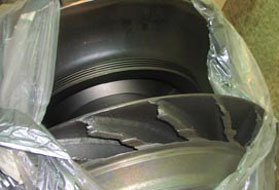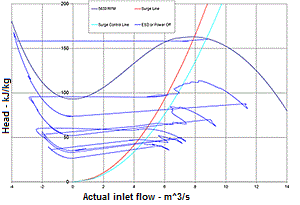Services
- Static Equipment & Structures (Piping Vibration & Fatigue)
- Acoustic Fatigue Assessment for Blowdown Systems
- Acoustic-Induced Vibration (AIV) Analysis
- Finite Element Analysis (FEA) and Computational Fluid Dynamics (CFD)
- Flow-Induced Turbulence (FIT) Analysis
- Flow-Induced Vibration (FIV) Analysis
- Multiphase and Slug Flow Analysis
- Pipe Stress Analysis
- Piping Vibration and Integrity Assessment
- Review & Design Support Services
- Small-Bore Connections (SBC) Assessment
- Structural Vibration and Dynamic Design Analysis
- Subsea Piping Vibration
- Thermal Striping
- Tube Failure Analysis
- Veridian AM
- Veridian VS
- Vibration Inspection Program
- Water Hammer Analysis
- Machinery Analysis
- Bottle Sizing Service
- Compressor Package Engineering
- Finite Element Analysis (FEA) and Computational Fluid Dynamics (CFD)
- Foundation Design and Dynamic Analysis
- Fuel Gas Compressor Piping Transient Analysis
- Lateral Vibration Analysis
- Pipe Stress Analysis
- Pulsation & Mechanical Analysis: Reciprocating Compressor
- Pulsation & Mechanical Analysis: Reciprocating Pump
- Pulsation & Mechanical Analysis: Screw Compressor
- Pump RCF Analysis
- Review & Design Support Services
- Shell Transverse Acoustical (STA) Analysis
- Skid Design and Analysis
- Surge Control Design for Centrifugal Compressor Systems
- Torsional Vibration Analysis (TVA)
- Field Engineering & Troubleshooting
- Finite Element Analysis (FEA) and Computational Fluid Dynamics (CFD)
- Human Vibration
- Motion Amplification Vibration Analysis
- Noise Troubleshooting
- Performance Assessment (Thermodynamic)
- PostPro – field data processing and analysis
- Structural Vibration Troubleshooting
- Thermal Striping
- Troubleshooting, Root Cause Analysis (RCA)
- Veridian iDAC
- Vibration Inspection Program
Surge Control Design for Centrifugal Compressor Systems
Three levels of dynamic surge analysis

Compressor reliability is directly affected by the interaction between the surge controller, piping system, valves, recycle lines and coolers. An improperly designed surge control system can lead to multiple surge events increasing the risk to personnel safety and major damage to the compressor.
There are many station events that can cause a centrifugal compressor to surge, such as interaction with other units, reciprocating compressor pulsations, and upset conditions like sudden power loss. To understand, model, and evaluate this risk, a complete station surge analysis is often required – even if an OEM has previously evaluated units on an individual basis.
This dynamic analysis is recommended for new compressor projects, when modifications are proposed for an existing system, or when the risk of an existing system going into surge needs to be determined.
We provide three levels of analysis to assist users in evaluating the optimal design for their surge control system, in terms of machine protection, station functionality and capital cost.
Contents [ hide ]
1 Purpose of Surge Control
 |
| Centrifugal compressor damaged during surge event |
 |
| ESD surge event (illustrating compressor instability during surge) |
A well-designed surge control system should effectively sustain positive flow through the compressor in sufficient time to save it from the effects of emergency shutdowns, fast stops, low flow periods and machine start-up. The piping system, recycle valves, and their controls are integral parts of the surge control system, all of which can severely affect the ability of the overall system to protect the compressor from surge, if not designed properly.
2 Factors Affecting Surge Control Design
Piping system: The piping system design drastically affects the performance of the surge control system. This has historically been a relatively overlooked piece of the system, because traditional surge control analysis techniques focus only on the overall volume of the piping network, not on the physical length and impedance of the system. Piping layout, placement of valves, recycle loop(s), and control valve functionality are especially important to a robust and reliable surge control system design. The piping system is also integral to the analysis in a multi-unit station where one centrifugal may cause another to surge if the piping system or recycle loops are shared.
Recycle valve selection and control scheme: A recycle valve’s characteristics, such as maximum capacity, flow percentage vs. opening % characteristics (trim), opening and closing delay, and valve travel time must be included and evaluated in surge analysis.
Instrumentation and surge limit model: The selection and placement of pressure, temperature, and flow metering will affect surge detection consequent control system response.
3 Surge Analysis
We provide three levels of analysis, each level increasing in complexity and accuracy. The appropriate level depends on project risk and surge sensitivity. An operator should carefully consider running the following analyses – even if the individual unit has been previously evaluated by an OEM:
Level 1 – Surge sensitivity analysis: Calculates a compressor’s Inertia Number as a non-dimensional value to determine the compressor’s surge probability and sensitivity. Offered as a free calculation tool the accuracy of this assessment depends on the data available for the project. Some assumed values for key parameters are offered to help users check the sensitivity of their particular compressor installation when data is scarce.
Level 2 – Time limit analysis (impedance method): A quick, one-week turnaround study to evaluate valve capacity and system response times compared to allowable maximum response times. The allowable response times are determined by the compressor response path during surge, otherwise known as the impedance line. This analysis also evaluates systems qualitatively to determine if typical high-risk issues are present and the amount of possible interaction from other units in a facility.
Deliverables include:
- Recycle valve sizes (including hot recycle if required)
- Maximum allowable valve response times
- Impedance line plots with a qualitative assessment of risk
Level 3 – Full dynamic simulation: This analysis uses a complete dynamic simulation of the compressor, driver, piping system, control valves, and control scheme. The simulation includes the negative flow regions of the operating map to assess each surge cycle and ensure complete machine protection after a successful design is developed. Operators have continually requested the full dynamic simulation in many high-risk cases previously thought to be safe from surge events.
Deliverables include:
- Most accurate prediction on the market for surge behavior of facilities
- Detailed recycle valve sizes and trim characteristics (including hot recycle, if required)
- Evaluation of piping layout and surge system component suitability
- Recommendations to address surge scenarios, when required
What if the Level 2 analysis indicates a further Level 3 analysis is required?
Costs for a Level 2 study can be deducted from the cost for a Level 3 study, if the latter is required. This avoids unnecessary costs and reduces the turnaround time if Level 2 has already been performed. The scope includes:
- Normal shutdown scenario
- Slow and fast transient analysis
- “What-if” scenarios requested by the operator
4 Wood Experience
Wood (formerly BETA) has performed numerous surge analyses of varying risk profiles for all three levels, including complex systems with gas turbine drives (both frame and aeroderivative), electric motor drives, torque converter coupled, and more.
This service is led by Dr. Kamal Botros, a senior advisor to Wood. Dr. Botros is a world authority on surge control design and analysis, and has focused his research activities on transient flow problems in complex systems, including centrifugal compressor surge phenomenon, pressure relief system dynamics, transients of two-phase stratified flows, interface mixing between batches in pipelines, fluid-structure interactions, and flow-induced vibration in heat exchangers.
In addition, our team is complemented by several surge control experts with wide-ranging centrifugal and rotating equipment expertise who can assist with Level 1 and 2 analyses, recycle valve sizing and selection and compressor interaction studies.
5 CENTRAN Software for Dynamic Simulations
Wood uses a dynamic simulation tool called CENTRAN, which is an industry-leading software for centrifugal compressor transient investigations. This dynamic model was developed by Dr. Kamal Botros after two decades of experimental and numerical investigations, and has been validated against field data and experimental setups. Compared to other lumped parameter methodologies, full dynamic simulation models include both spatial variations in the larger piping system and temporal effects such as valve opening times. Both of these parameters are critical to simulation accuracy and can both affect the response time of the real-world surge control system.
6 Contact and Support
Contact us today to find out which level of surge analysis is required in your facility, and how we can help you build a safe and reliable surge control system.
7 Free Calculator
Try out our free surge sensitivity calculation tool to calculate your inertia number and determine the required analysis for your system.
Related Information
- Webinar: What is my risk of surge? (on-demand webinar)
- Paper: A New Approach to Designing Centrifugal Compressor Surge Control Systems (PDF)
- Handout: Surge Control Design for Centrifugal Compressor Systems (PDF)
- Paper: Application of Three Methods in Determining Effectiveness of Surge Protection Systems in Gas Compressor Stations (ASME)
- Guideline: GMRC Application Guideline for Centrifugal Compressor Surge Control Systems (GMRC)
- Book: Pipeline Pumping and Compression Systems: A Practical Approach, (second edition), by Dr. K. Botros and T. Van Hardeveld (ASME PRESS, 2013)
Related Services
- Flow-Induced Vibration (FIV) Analysis
- Acoustic-Induced Vibration (AIV) Analysis
- Pipe Stress Analysis
Keywords
- Centrifugal compressor vibration
- Transient modeling of gas systems
- Surge control in centrifugal compressors
- Dynamic surge analysis
- Anti-surge valve (ASV)
- Hot recycle system
- Hot gas bypass valve (HGBV)
- Cold recycle system
- Cold gas bypass valve (CGBV)
Free webinar
Learn how to select and design vibration control solutions that work – using real-world data and case studies. Register now



